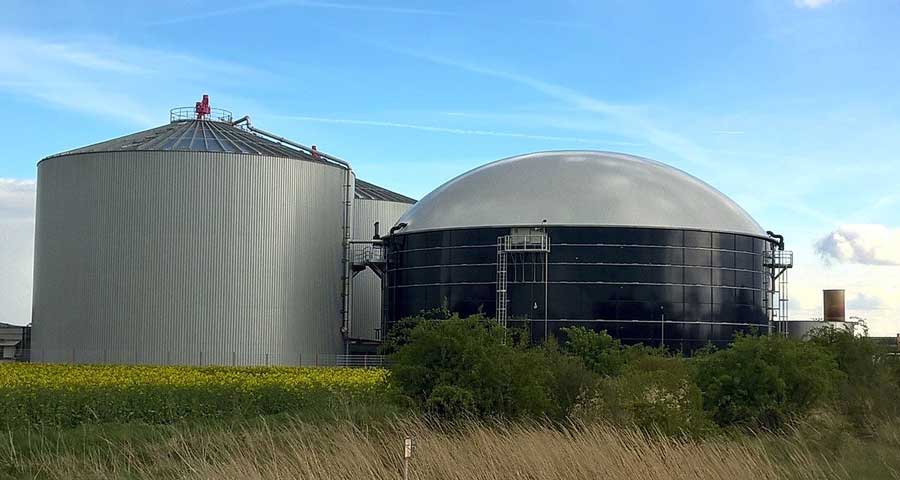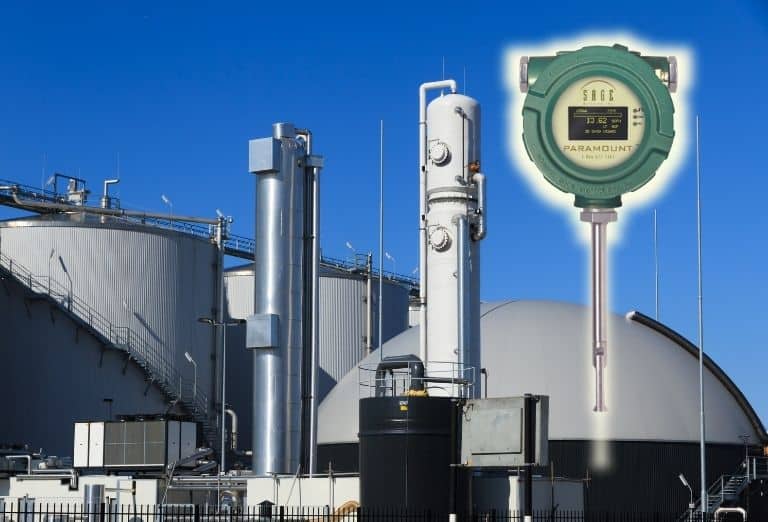Accurately measuring biogas is challenging, yet thermal mass flow meters are ideal for biogas measurement. Learn how the Sage biogas flow meter monitors gases from anaerobic, agricultural, or wastewater digesters and meets the demands of many protocols employed to measure, manage and report greenhouse gas emissions.
Why is biogas production increasing?
Worldwide, humankind creates waste, and as it breaks down, it produces methane. Methane, while natural, is a potent and destructive greenhouse gas (GHG) contributing to global warming. With the current drive to reduce emissions and reduce our use of fossil fuels, producing renewable natural gas (RNG) from waste is a strategy to help reduce fugitive methane emissions. Renewable natural gas (RNG or biomethane) is upgraded biogas. Initially, biogas was used to generate electricity or fuel for on-site use. Today much of the biogas is upgraded and introduced into the natural gas grid.
Pictured above is a digester from a farming operation.
What is biogas?
Biogas is any gas that derives from biomass sources in the absence of oxygen. The origins are typically food scraps, animal manure, and crop residues. Dairies and farms repurpose their organic waste to produce agricultural biogas. Organic waste at wastewater treatment plants creates wastewater biogas, and landfills generate landfill gas.
One creation process can occur in an anaerobic digester to produce biogas (digester gas). Biogas is primarily a mixture of methane (about 70%) and carbon dioxide (about 30%). The complete biogas production process involves gas creation, cleansing, storage, and, ultimately, using biogas as a fuel source for heating or generating electricity.
Forms of biogas:
-
- Digester gas
- Landfill gas
- Agricultural biogas
- Wastewater biogas
Greenhouse Gas Protocols
Measurement of any resource is necessary throughout a typical process with any production. Additionally, many biogas recovery systems comply with various projects and protocols requiring measuring or monitoring greenhouse gas emissions. Project verification plays a vital role in upholding the integrity and quality of the data reported to mandatory and voluntary greenhouse gas (GHG) programs worldwide. Here are a few protocols, though many others require measuring biogas.
-
- The Greenhouse Gas Protocol (GHG Protocol) provides standards, guidance, tools, and training for businesses and governmental agencies to measure and manage climate-warming emissions.
- The Organic Waste Composting (OWC) Protocol provides standards for quantifying and monitoring GHG reductions from projects that avoid methane emissions by diversifying and composting municipal food and food-soiled paper waste.
- The Kyoto Protocol is an international treaty adopted in 1997 to reduce gases that contribute to global warming.
Challenges of Biogas Measurement
There are inherent challenges for any flow technology to measure biogas accurately:
-
- Biogas composition changes based on the biomass source and can change over time with changing conditions in the digester tanks or landfills.
- Biogas is dirty and often has high moisture content. The gas can clog or gum up meters, particularly with moving parts, such as turbine meters, orifice plates, or averaging Pitot tubes.
- Since biogas is generally low flow and low pressure, differential pressure meters are unacceptable since they require a reasonably significant differential pressure.
Sage Biogas Flow Meter
The thermal mass flow meter has emerged as the most effective gas measurement technology for many biogas or greenhouse gas emissions applications. The Sage Paramount is an ideal biogas flow meter, whether a biogas application is in food processing, fermentation towers, or slaughterhouses. Measuring biogas flow at several points in a system provides operators with critical information for optimal gas production, control, and safety.
The Sage meter features ease of installation, accurate and repeatable direct mass flow measurement (no need for ancillary pressure and temperature devices), wide turndown, and built-in software verification for protocol compliance. Their ability to perform with extremely low flow (low velocity), typical of biogas, is unique to the technology. Sage’s innovative approach to contending with changing composition enables accurate and reliable measurement. To learn more, read our Biogas Application Guide, call us today, or message us now.
The thermal mass flow meter is ideal for monitoring greenhouse gas emission reductions and satisfying regulatory protocols.



